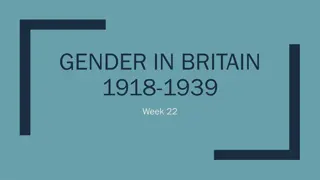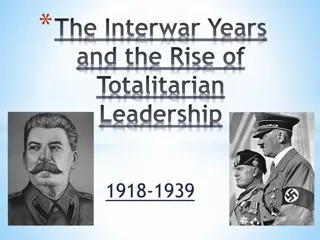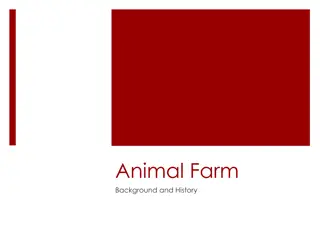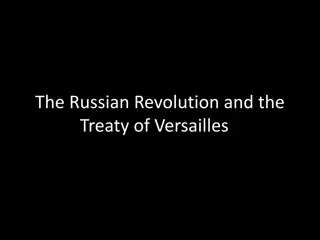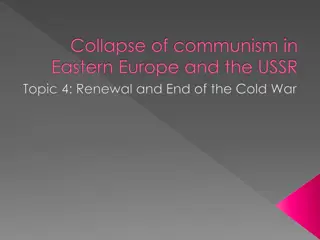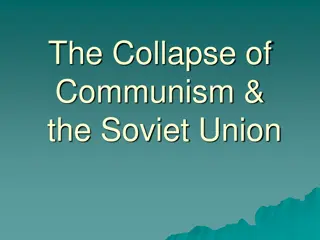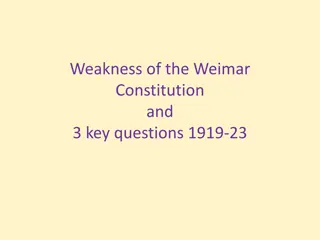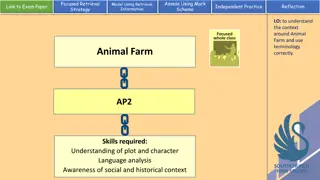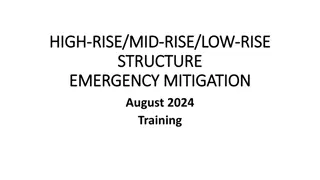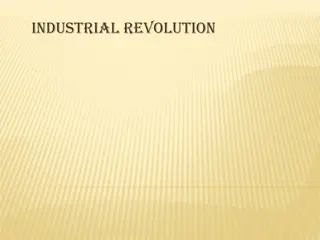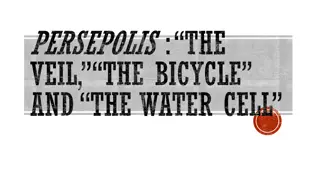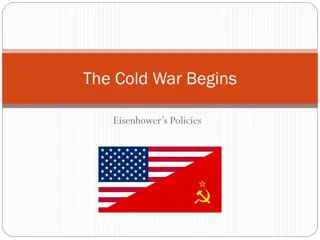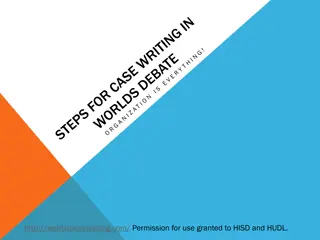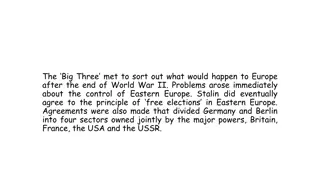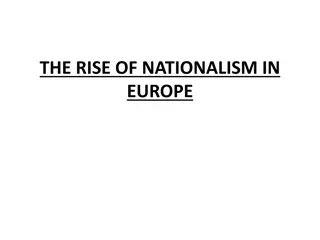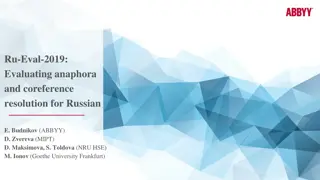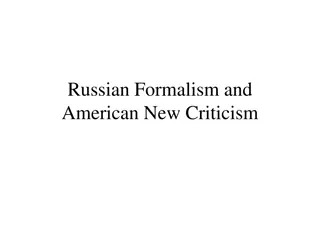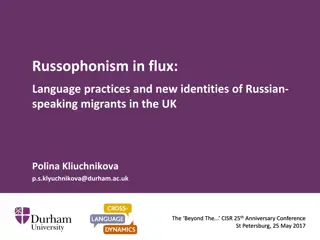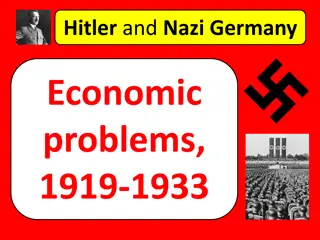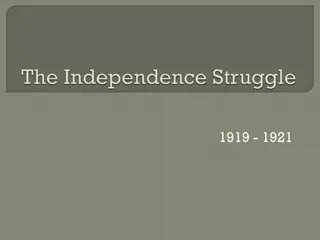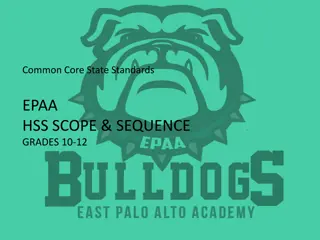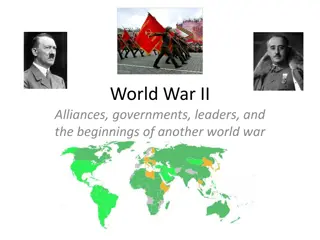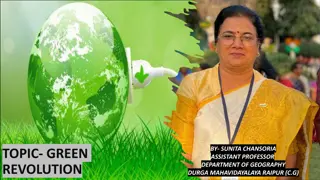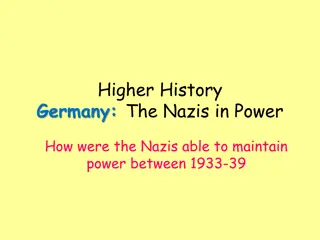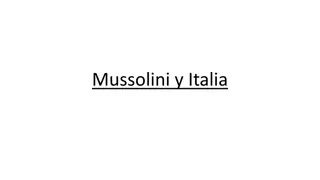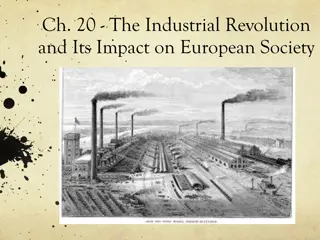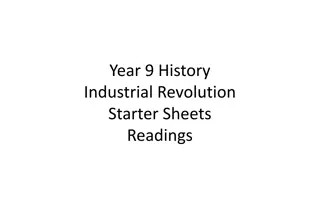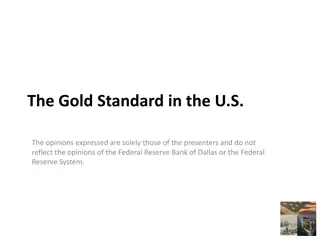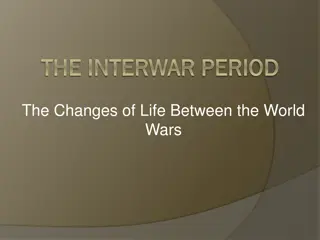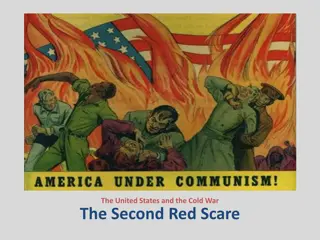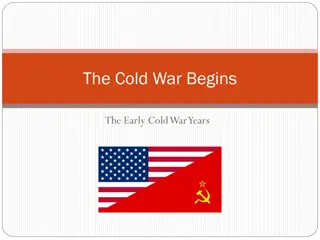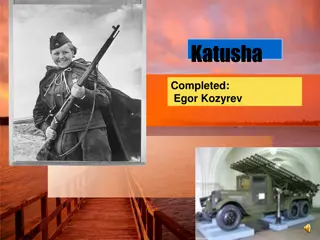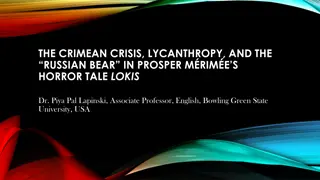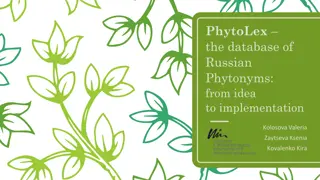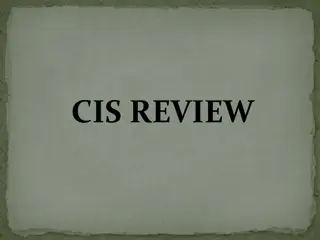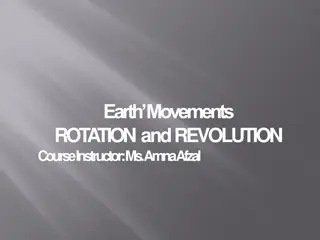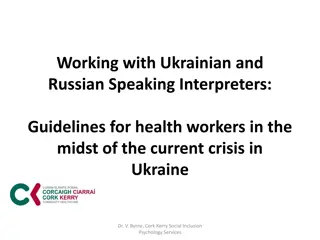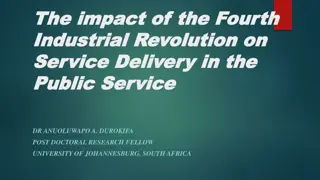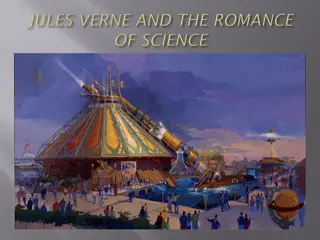The Russian Revolution and Rise of Communism: Interwar Years (1919-1939)
Explore the significant historical events of the Russian Revolution and the emergence of modern communism during the interwar period. Understand the ideological, social, and political circumstances that shaped this transformative era, including the leadership of key figures like Lenin and Czar Nicholas II.
Download Presentation

Please find below an Image/Link to download the presentation.
The content on the website is provided AS IS for your information and personal use only. It may not be sold, licensed, or shared on other websites without obtaining consent from the author. Download presentation by click this link. If you encounter any issues during the download, it is possible that the publisher has removed the file from their server.
E N D
Presentation Transcript
UNIT V The Interwar Years: Revolution and Nationalism (1919-1939) Part 1
UNIT V ENDURING UNDERSTANDINGS: International conflict often leads to domestic changes. In times of crisis, people often turn to strong leaders in search of stability. Conflicts of the 20thCentury were rooted in political and ideological differences around the world.
UNIT V ESSENTIAL QUESTIONS: Describe the long-term and short-term causes of the Russian Revolution. Focus particularly on ideology, social, economic, military and political conditions. Are all revolutions the same? Compare the Russian Revolution to the French Revolution.
THE RUSSIAN REVOLUTION AND THE RISE OF MODERN COMMUNISM
INTRODUCTORY VOCAB QUIZ Who was the leader of the provisional government in Russia? What was the name of the Russian Parliament? What was the name of the wealthy peasants in Russia? What political group was led by Vladimir Lenin? What term refers to organized waves of violence ? Who was the last Czar of Russia? 1) 2) 3) 4) 5) 6) 7) Plan of Lenin s to promote financial growth in Russia- allowed for small scale capitalism. 8) Peaceful protest against the Czar in 1905 that ended violently. 9) Government created art to promote the Communist state. 10) Ruthless leader of Russia that used fear and secret police to control his people.
GROUP ASSIGNMENT: CONSTRUCT A TIMELINE THAT EXPLAINS THE KEY EVENTS THAT OCCURRED IN RUSSIA DURING THE TIME PERIOD OF THESE RUSSIAN LEADERS. Lenin Nicolas II Kerensky Alexander III
REQUIRED TIMELINE EVENTS: Lenin s return to Russia Reign of Czar Alexander III Russian Civil War Establishment of Bolshevik rule /Creation of the USSR Brest-Litovsk Treaty March Revolution Put in chronological order. Lenin s death Start of World War I Provide brief explanation of events Bloody Sunday Reign of Czar Nicolas II Russo-Japanese War Establishment of Provisional Government Bolshevik Revolution The Red Terror Execution of the Romanovs
TIMELINE EVENTS: CORRECT CHRONOLOGY Reign of Czar Alexander III Reign of Czar Nicolas II Russo-Japanese War Bloody Sunday Start of World War I March Revolution Create timeline Establishment of Provisional Government Bolshevik Revolution Provide brief explanation of each events Lenin s return to Russia Brest-Litovsk Treaty Russian Civil War The Red Terror Execution of the Romanovs Establishment of Bolshevik rule /Creation of the USSR Lenin s death
CAUSES OF THE RUSSIAN REVOLUTION 1. Autocratic rule of the Czars 2. Industrialization and resulting worker discontent 3. Russo-Japanese War 4. Bloody Sunday 5. World War I 6. Failures of the Provisional Government
CAUSES OF THE RUSSIAN REVOLUTION POLICIES OF THE CZARS Russia s 19th-century czars: Cruel oppressive, and autocratic Peasants lived in poverty and had no rights. Their ruthless treatment created widespread social unrest and led to violent uprisings Alexander III (1881-1894) used harsh tactics to crush opponents. Turned Russia into police state teeming with spies and informers. Czar Alexander III Oppressed non -Russians and carried out pogroms against Russia s Jews.
CAUSES OF THE RUSSIAN REVOLUTION POLICIES OF THE CZARS The principle of autocracy will be maintained Nicolas II (son of Alexander III) , became Czar in 1894. Refused to surrender any of his power. Vowed to maintain autocratic rule. Blind to changing conditions of his time. Never visited any factories or farms. Had little understanding of working conditions. Weak and ineffective ruler. Czar Nicolas II
CAUSES OF THE RUSSIAN REVOLUTION WORKER DISCONTENT Industrialization created problems and discontent. What problems? Angry factory workers felt exploited: Miserably low wages Grueling working conditions Child labor Labor unions outlawed. No political power Enormous gap between rich and poor. Karl Marx The Communist Manifesto Various radical groups plotted revolutions, including Marxist who tried to ignite revolution among the proletariat
CAUSES OF THE RUSSIAN REVOLUTION THE RUSSO-JAPANESE WAR Russia lost war to Japan in 1905. Expected an easy victory to raise morale. Embarrassed to lose war against a second rate power . Russian fleet had sailed for six months to engage the Japanese and was destroyed in under an hour. Humiliating defeat sparks social unrest at home.
CAUSES OF THE RUSSIAN REVOLUTION 1905 REVOLUTION / BLOODY SUNDAY In 1905, workers marched in St. Petersburg to demand better working conditions and a say in government. Russian soldiers opened fire on protestors. Hundreds were killed in Bloody Sunday. A Duma (parliament) created to give people a voice but the Czar dissolved it 10 weeks later. Reading on Bloody Sunday
CAUSES OF THE RUSSIAN REVOLUTION WORLD WAR I Czar took unprepared Russia into war with Germany in 1914. Weak generals and poorly equipped soldiers no match for German army. Russian army suffered defeat after defeat and lost 4 million casualties within first year. Soldiers mutinied and deserted by the thousands. Social unrest at home caused by food and fuel shortages.
RASPUTIN In an effort to increase troop morale, Nicholas went to the front, leaving Czarina Alexandra in charge of the government. Alexandra fell under the spell of Rasputin, a self-proclaimed holy man who claimed to have magical healing powers. Rasputin s influence over the Czarina gave him great power. Murdered by Russian nobles in 1916. Why? Rasputin
THE MARCH REVOLUTION, 1917 Huge uprising of workers spread throughout Russia. Soldiers sent to put down the rebellion joined it instead. Czar Nicolas forced to abdicate his throne. Nicolas II would be Russia s last Czar Weak provisional (temporary) government replaced Czar s regime.
CAUSES OF THE RUSSIAN REVOLUTION PROVISIONAL GOVERNMENT S MISTAKES Provisional government decided to continue Russia s involvement in World War I. Lost support of both soldiers and civilians). Failed to address the concerns of Russia s peasants (no land reform). Resulted in growth of local Soviets (councils) made up of workers, peasants, and soldiers unhappy with the lack of reform. Alexander Kerensky
RUSSIAN MARXISTS DIVIDED Bolsheviks Mensheviks Means minority Means majority Wanted to implement communism in Russia Wanted to implement communism in Russia Wanted to educate the people about communism Believed in radical quick implementation w/out popular consent Slow process to gain popular support Elite group (themselves) would take charge. Grass roots movement EMERGED AS DOMINANT SOCIAL REVOLUTIONARY GROUP
VLADIMIR LENIN Influenced by ideas of Karl Marx Committed to class struggle and revolution. Organized Bolsheviks elite group of radicals committed to carrying out revolution in Russia. Promised Peace, Land, and Bread Supported by suffering peasants Workers & Soldiers angry with government s failure to address their needs. Germans helped Leninreturn to Russia in 1917 after several years in exile. Why? Lenin's Return Vladimir Lenin 1870-1924 Reading on Lenin
NOVEMBER, 1917 THE BOLSHEVIK REVOLUTION What happened? Bolshevik soldiers seized control of the Winter Palace (government buildings in Petrograd) and arrested leaders of the provisional government. Uprising in Petrograd All power to the Sovietsbecame the rallying cry of the Bolsheviks. Lenin named as head of new socialist government within hours.
RUSSIAN CIVIL WAR, 1918-1920 The Bolshevik revolution was opposed by elements of the army and government loyalists from many social groups united by their hatred of Communism . Civil war broke out between White Army made up of government loyalists and the Red Army of Bolsheviks ( the Reds ). Red Army troops White Army troops
THE RED TERROR OF 1918-1920 Tens of thousands of class enemies were imprisoned and executed without trial by the Bolsheviks during the civil war. Victims included clergymen, aristocrats and wealthy bourgeoisie, deserters from Red Army, and political opponents of all kinds.
THE FATE OF THE ROMANOVS During the early hours of July 17, 1918 Czar Nicholas, his wife Alexandra, his five children, and their servants were herded into the cellar of their prison house and executed. Liberation by the White Army was imminent and the Reds wanted to get rid of the Czar and his family.
In addition to the royal family, the Reds executed their doctor, cook, valet, maid and dog.
END OF THE RUSSIAN CIVIL WAR, 1920 Western Allies (including Britain, France, Japan, and the U.S.) sent troops to support the White Army. Western intervention was half-hearted and ineffective and the Reds defeated the White Army after three years of war. 15 million Russians died in this conflict! Leon Trotsky Red Army Commander
ACTIONS OF THE BOLSHEVIKS IN POWER Land was redistributed to the peasants who were already seizing and dividing up the estates of the landlords and the church. Workers given control of mines and factories. Signed the Brest-Litovsk treaty with Germany pulling Russia out of WWI, which Lenin had always opposed as a Capitalist/imperialist war.
LENINS NEW ECONOMIC POLICY State controlled large industries and banks. Allowed small-scale capitalism. Individuals could buy and sell goods for profit. Peasants controlled own plots of land and could sell surplus crops. Lenin saw this as a temporary retreat from Communism . Lenin s reforms revived Russia s economy.
RUSSIA RENAMED THE UNION OF SOVIET SOCIALIST REPUBLICS To keep nationalism in check, Lenin organized Soviet Union into smaller self-governing republics under the central government s control from new capital: Moscow.
THE ONE-PARTY STATE OF THE USSR Bolsheviks rename their party the Communist Party Soviet Union was a one-party state with Communist Party in complete control. This dictatorship of Communist Party was NOT the dictatorship of the proletariat envisioned by Karl Marx.
LENINS DEATH Lenin suffered series of strokes and died in 1924. His death led to a power struggle for control of the Communist Party and the country. Lenin wanted Trotsky, the Party chose Stalin. Lenin s successor wasn t decided until 1928.
BELIEVE IT OR NOT! Lenin s embalmed corpse has been carefully preserved and has been on public display in Moscow s Red Square since his death in 1924. Lenin s Tomb!
Millions of people have visited Lenins tomb, waiting in long lines to view his body.
JOSEPH STALIN, MAN OF STEEL Stalin was cold, paranoid, ruthless, and ambitious. Used his position as General Secretary to gain complete control of Communist Party. Named to succeed Lenin in 1928. Wasn t Lenin s choice.
Stalin is too rude and this defect, although quite tolerable in our midst and in dealing among us Communists, becomes intolerable in a Secretary-General. That is why I suggest the comrades think about a way of removing Stalin from that post - Lenin Lenin and Stalin
LEON TROTSKY Bolshevik leader, Commander of the Red Army, Commissar of Foreign Affairs in new Soviet government. Lenin s preferred choice as his successor. Trotsky and Stalin became bitter rivals. What happened to Trotsky? Forced into exile in 1929 and, in 1940, was murdered in Mexico by agents of Stalin.
Trotskys Deathbed The murder weapon
STALIN TAKES CONTROL Stalin s focus wasn t on Lenin s worldwide worker s revolution. What was Stalin s focus on? Making the Soviet Union a great power. How? Focused on military and industrial development. Transformed the USSR into a totalitarianstate to achieve his goals.
WHAT IS TOTALITARIAN GOVERNMENT? Describes a government that takes total control over all aspects of public and private life. Several totalitarian states emerge during the 20th century. Where?
THE 20THCENTURY TOTALITARIAN STATES EMERGE Communist China Nazi Germany Italy Soviet Union North Korea Today
KEY TRAITS OF TOTALITARIANISM Dictatorship and one-party rule. Personality cult centered on a dynamic leader. Ideology (set of beliefs) which glorifies the goals of the state. State control over all aspects of society. State control over the individual. State demands total obedience and denies basic liberties. Uses mass media to spread propaganda in attempt to control what people think. Organized violence: Uses force and police terror to crush all opposition. Targets certain groups, such as national minorities and political opponents, as enemies of the state. Complete packet page 15


